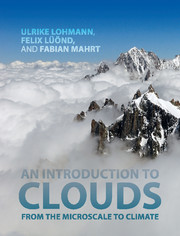Book contents
- Frontmatter
- Dedication
- Contents
- Preface
- List of symbols and acronyms
- 1 Clouds
- 2 Thermodynamics
- 3 Atmospheric dynamics
- 4 Mixing and convection
- 5 Atmospheric aerosol particles
- 6 Cloud droplet formation and Köhler theory
- 7 Microphysical processes in warm clouds
- 8 Microphysical processes in cold clouds
- 9 Precipitation
- 10 Storms and cloud dynamics
- 11 Global energy budget
- 12 Impact of aerosol particles and clouds on climate
- References
- Index
2 - Thermodynamics
Published online by Cambridge University Press: 05 June 2016
- Frontmatter
- Dedication
- Contents
- Preface
- List of symbols and acronyms
- 1 Clouds
- 2 Thermodynamics
- 3 Atmospheric dynamics
- 4 Mixing and convection
- 5 Atmospheric aerosol particles
- 6 Cloud droplet formation and Köhler theory
- 7 Microphysical processes in warm clouds
- 8 Microphysical processes in cold clouds
- 9 Precipitation
- 10 Storms and cloud dynamics
- 11 Global energy budget
- 12 Impact of aerosol particles and clouds on climate
- References
- Index
Summary
Thermodynamics describes the behavior of matter on a macroscopic scale, looking at it as a continuum rather than the sum of its atomic or molecular constituents. In this chapter we review the thermodynamics necessary for the understanding of cloud formation. We start by defining in Section 2.1 some fundamental terms, which will be used throughout the textbook. We discuss the physical laws that describe processes in dry air and introduce the concept of air parcels in Section 2.2. Since thermodynamic processes that involve adiabatic changes can best be visualized with the help of thermodynamic charts, the use of tephigrams is introduced in Section 2.3.We then move to moist air, i.e. a mixture of dry air and water vapor. Water is a unique substance because it exists in all three phases (ice, liquid water and water vapor) in the atmosphere. The transitions between its different phases are crucial for the understanding of liquid and ice cloud formation and microphysical processes inside clouds. They are the subject of Section 2.4. We end the chapter by extending the laws introduced for dry air to moist air, in order to analyze how water vapor influences certain processes; this enables us to predict the conditions under which a cloud is formed (Section 2.5).
Basic definitions
Thermodynamic states and variables of state
The aim of thermodynamics is to describe the spatially and temporally averaged properties of macroscopic systems of gases, liquids or solids. The concepts of thermodynamics are suitable for systems containing a number of molecules on the order of the Avogadro constant (NA = 6.022 x1023 mol-1) and changing slowly in time. Considering a large, macroscopic, quantity Q of a substance also justifies the assumption of negligible edge effects, which is usually made in thermodynamics.
In reality the quantity Q consists of a large number of molecules N each of whose instantaneous state can be described by 6N coordinates (three for the spatial position x, y, z, and three for the momentum components of each molecule, mu, mv, mw). Such a state is called a “microstate” of the system. For most practical purposes, to describe a system in terms of its microstates is too complicated, i.e. to solve the equations of motion with 6N degrees of freedom. Furthermore, it would be meaningless because microstates cannot be directly observed.
- Type
- Chapter
- Information
- An Introduction to CloudsFrom the Microscale to Climate, pp. 26 - 67Publisher: Cambridge University PressPrint publication year: 2016

